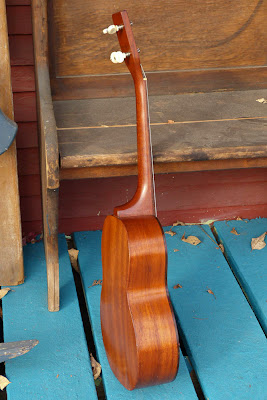c.1950 Harmony Baritone Ukulele
This fella is a nice old early-50s Harmony solid-mahogany baritone. How does one know it's early 50s? Well... the neck profile is slimmer, the woods are slightly nicer (and much thinner than late 50s/60s ones), and the sound is thus comparable juicier and more resonant. I worked on one a couple years ago that I swear was from the first batch, very late 40s, that was fantastic. I've only played two since then (this being one of them) that came close to that mark.
Anyway, while there are no cracks, I had to do some of the usual work I expect to do on these when I buy them for fixing: a fret level/dress, bridge or saddle shave (and sometimes modification as in this case), cleaning, and setup. I also fussed with the firction pegs a bit (cut the set-screws down to give them more adjustment room) to keep them useful for the next 60+ years.
While you can't really see it in the pictures, there are little scratches, scuffs, and patches of finish checking throughout the instrument. Still, it looks pretty darn good.
The lower bout top below the bridge has a tiny amount of belly/distortion which is uncommon on these guys but actually much more common on the Favillas I've worked on, which have similarly thin tops like the one on this particular bari. It doesn't hurt the instrument but it is there.
The lower bout top below the bridge has a tiny amount of belly/distortion which is uncommon on these guys but actually much more common on the Favillas I've worked on, which have similarly thin tops like the one on this particular bari. It doesn't hurt the instrument but it is there.
50s Harmony baris (which have this style label at the headstock) tend to also have bone nuts and saddles, which are improvements over the (later) plastic ones.
The fretboard and bridge are Brazilian rosewood and the frets are brass. The dots are faux-pearl plastic.
The only decorative touches are the single-ring rosette and tortoise top binding.
For string back-angle and action reasons, I removed the classical-style tie-block bridge system, shaved down the saddle, and converted this to a modified pin-style system. In this variation you pass the string through the hole in the bridge top, pull it out of the soundhole and knot it, and then pull it back up to the tuner and tune up.
I like this over a truly pin-bridge system as it has fewer parts to fall out, rattle, or otherwise annoy the owner. Since uke strings tend to stay on for a while, the extra 30 seconds of fishing the strings out of the soundhole doesn't seem to be a bad compromise for that!
The bridge wings are a different color from the freshly-shaved areas (even though I sanded them down and re-polished them) because they had some thick gloss finish applied from the factory that trapped either an originally bright color or discolored them over time.
The sides show a bit more weatherchecking to the finish but, like the rest of the uke, the mahogany is crack-free and in good shape.
The simple friction pegs work just fine.
Oona made me grab a fashion shot of her with it!
















Comments